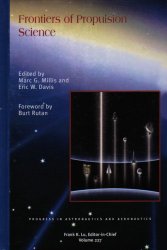Engineering Bookshelf
- Aerospace
- Biological
- Civil
- Chemical
- Environmental
- Electrical
- Materials
- Mechanical
- Petroleum
- Geoengineering
- Software

Frontiers of Propulsion Science (Progress in Astronautics and Aeronautics)
by M. Millis, E. DavisPublisher: AIAA
ISBN: 1563479567
Check price @ amazon.com , amazon.ca , amazon.co.uk
Book Description
"Frontiers of Propulsion Science" is the first-ever compilation of emerging science relevant to such notions as space drives, warp drives, gravity control, and faster-than-light travel - the kind of breakthroughs that would revolutionize spaceflight and enable human voyages to other star systems.
Although these concepts might sound like science fiction, they are appearing in growing numbers in reputable scientific journals. This is a nascent field where a variety of concepts and issues are being explored in the scientific literature, beginning in about the early 1990s. The collective status is still in step 1 and 2 of the scientific method, with initial observations being made and initial hypotheses being formulated, but a small number of approaches are already at step 4, with experiments underway. This emerging science, combined with the realization that rockets are fundamentally inadequate for interstellar exploration, led NASA to support the Breakthrough Propulsion Physics Project from 1996 through 2002.
"Frontiers of Propulsion Science" covers that project as well as other related work, so as to provide managers, scientists, engineers, and graduate students with enough starting material that they can comprehend the status of this research and decide if and how to pursue it in more depth themselves.
Five major sections are included in the book:
- Understanding the Problem lays the groundwork for the technical details to follow
- Propulsion Without Rockets discusses space drives and gravity control, both in general terms and with specific examples
- Faster-Than-Light Travel starts with a review of the known relativistic limits, followed by the faster-than-light implications from both general relativity and quantum physics
- Energy Considerations deals with spacecraft power systems and summarizes the limits of technology based on accrued science; and, From This Point Forward offers suggestions for how to manage and conduct research on such visionary topics.
About the Author
Marc Millis headed NASAs Breakthrough Propulsion Physics Project at NASA Glenn Research Center, and continues research on gravity control and faster-than-light travel on his discretionary time. This research gained wide public attention, including a 2001 cover story in Popular Science magazine. In 2006 Millis created the Tau Zero Foundation to extend interstellar flight investigations beyond what is addressable within his day job at NASA. Milliss other NASA work spans ion thruster designs, electronic instrumentation, and even a cockpit display to guide aircraft microgravity flights. He earned a BS in Physics from Georgia Tech and an MS in Physics Entrepreneurship from Case Western Reserve University.
Eric Davis is a Senior Research Physicist at the Institute for Advanced Studies at Austin, and the CEO of Warp Drive Metrics. His research specializations include breakthrough propulsion physics, general relativity, and quantum field theories. He is a technical contributor and consultant to the NASA Breakthrough Propulsion Physics Program. His graduate research included the Voyager 1 & 2 and IRAS space missions. Davis has authored papers on the vacuum zero-point energy, wormholes, warp drives, and laser propulsion. He earned an AA in Liberal Arts from Phoenix College, a BS and PhD in Physics from the University of Arizona, and is a Fellow of the British
Customer Reviews
By Tristan Renaud
The book is for engineers or scientists and cannot be read that easily. But it is a must have. The exceptional review and descriptions of breakthrough technologies and - even more important - how we should evaluate / consider other new ways, concepts, ideas to let space journey to the star doable is really fantastic.
By Barry S. Roffman
For three decades I taught science. I was even an applicant for the Teacher in Space program. Fortunately, I wasn't selected for the fatal Challenger flight, but like many in my generation, I still waited in vain for the natural follow up to our moon flights - a manned landing on Mars. I dreamed of voyages like that seen on Star Trek too.
In 1997 I began what seemed like an unrelated field of research. There were claims that a predictive Code had been placed in the Torah. The most successful author of a book dealing with the Bible Code thought it was written not by God, but by aliens. By 2004 I had published my own book on the topic (Ark Code), and I had appeared on the History Channel to discuss some of my findings. As I began to read through emails about the TV appearance, I found that a few came from people who were high in our Government, or in a position to know a lot about UFOs based on their placement in NASA.
In exchange for insight into what was really going on, I checked the Torah Codes and published a few Bible Code UFO matrices on my web site. Much of what I heard in return was related to bizarre claims about how UFOs are powered. There came a point at which some of it overlapped what was being asserted in Nick Cook's best seller, The Hunt for Zero Point. However eventually it became clear that I could not address any claims about interstellar propulsion in a serious manner unless I mastered the language and mathematics of the field.
There was, until February, 2009, no textbook that dealt with Breakthrough Propulsion Physics. Frontiers in Propulsion Science quickly wiped out this deficit.